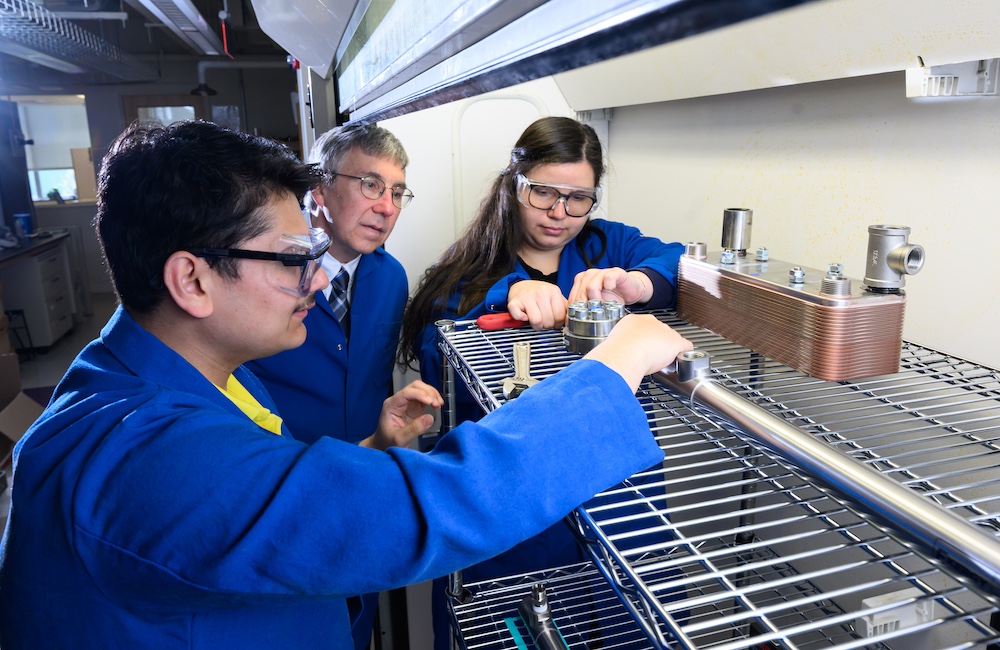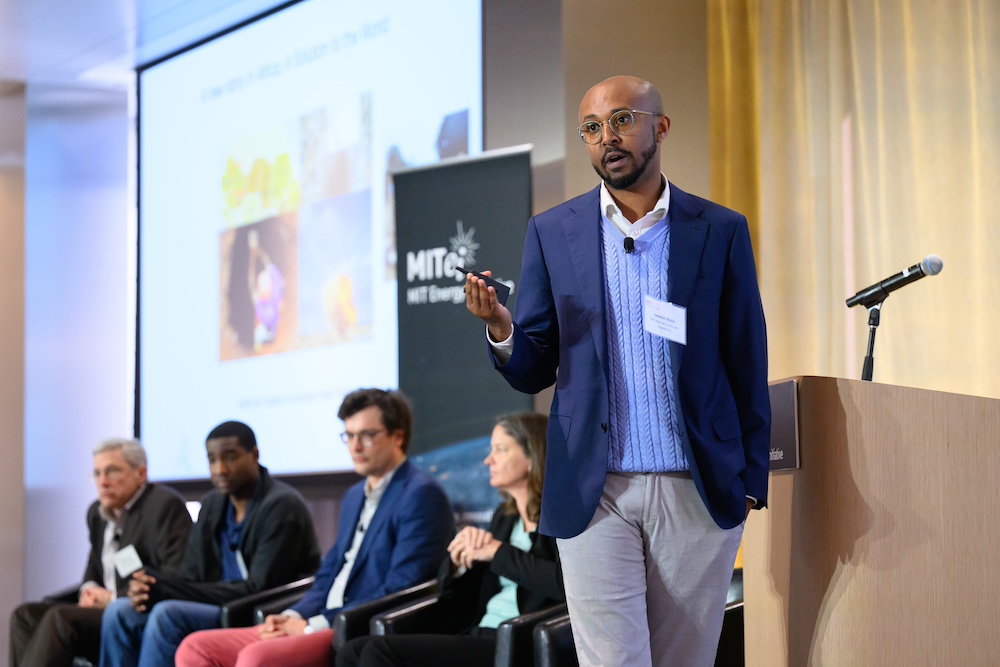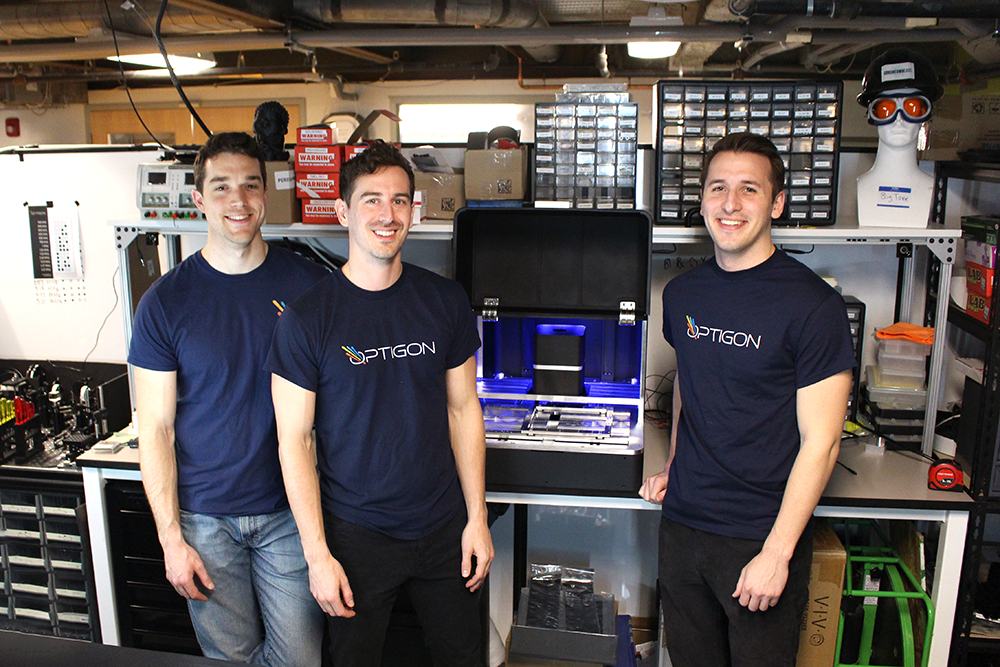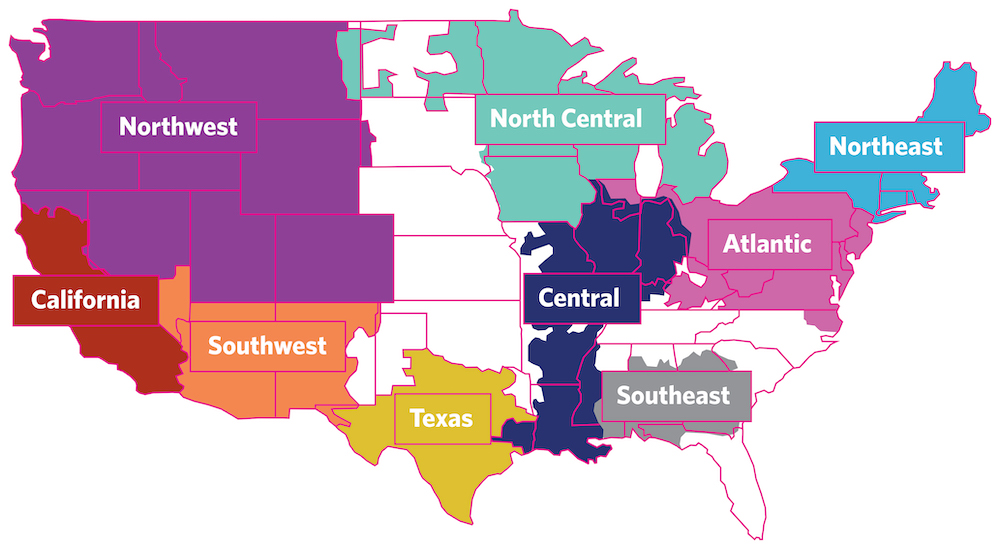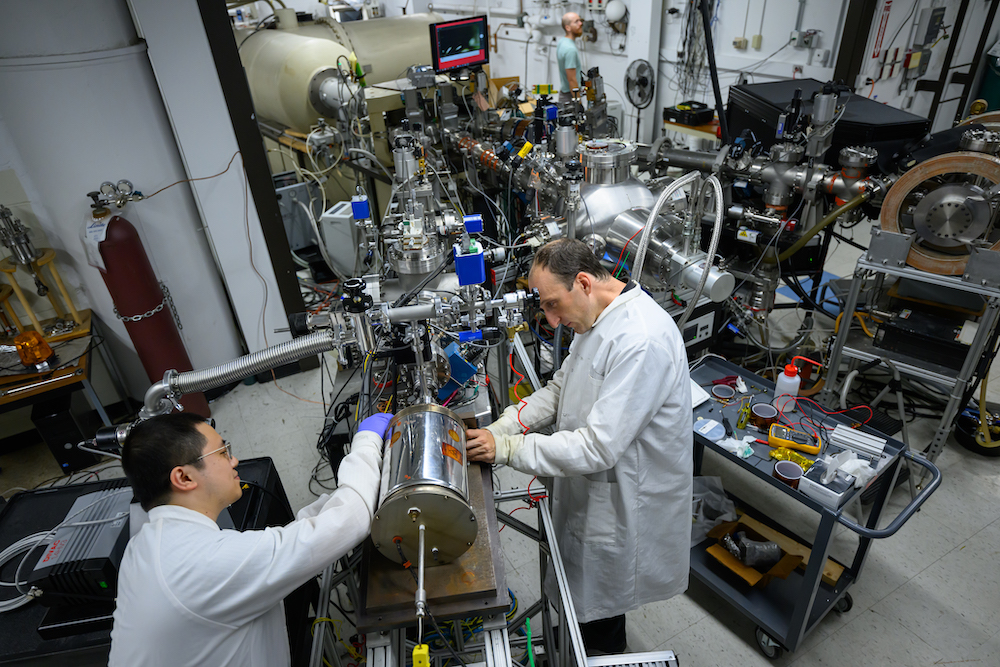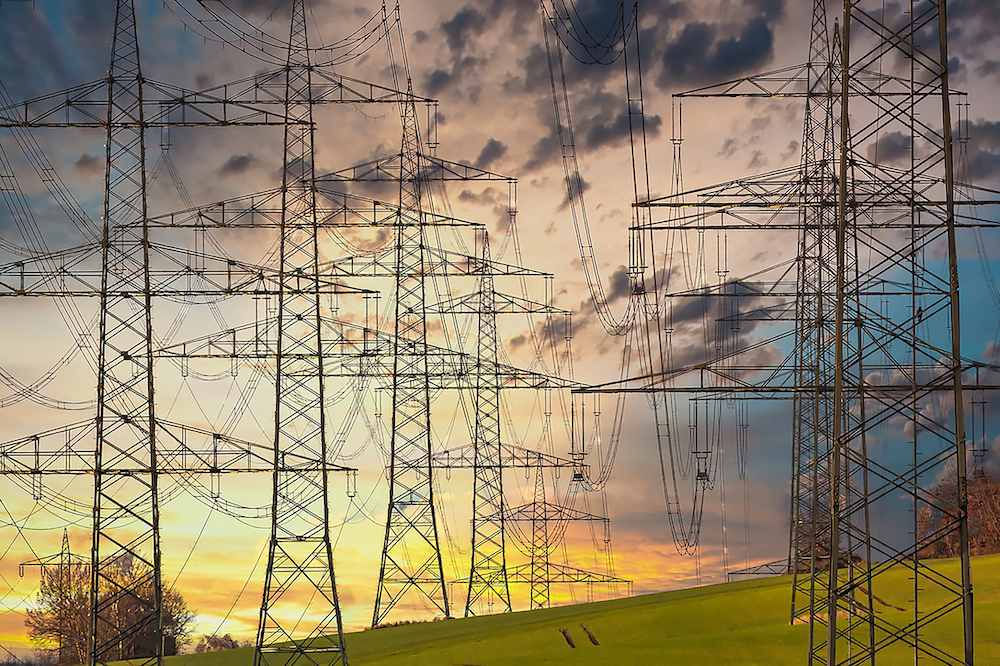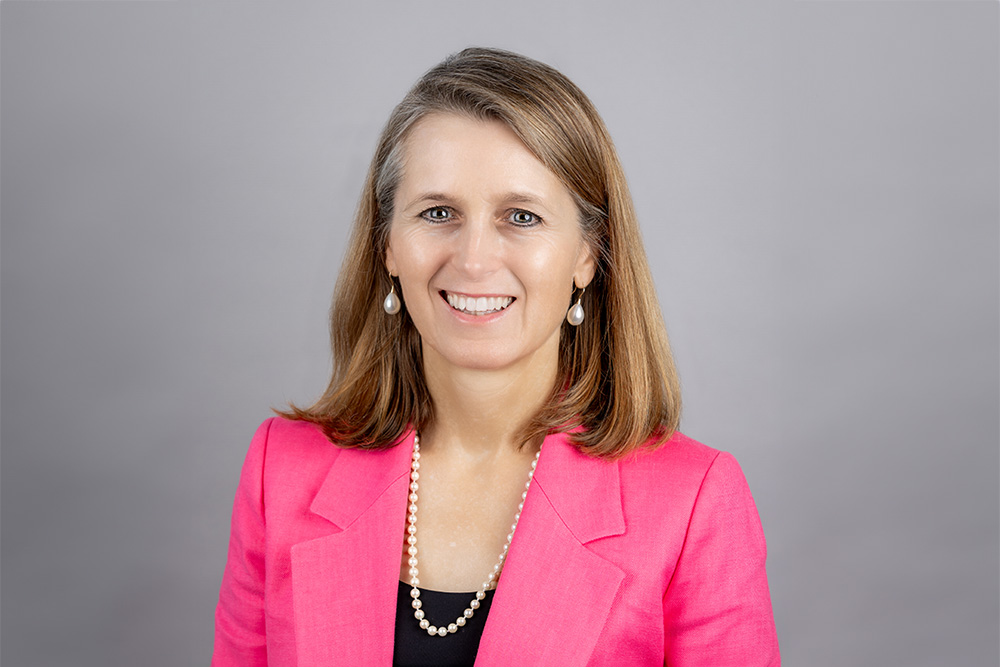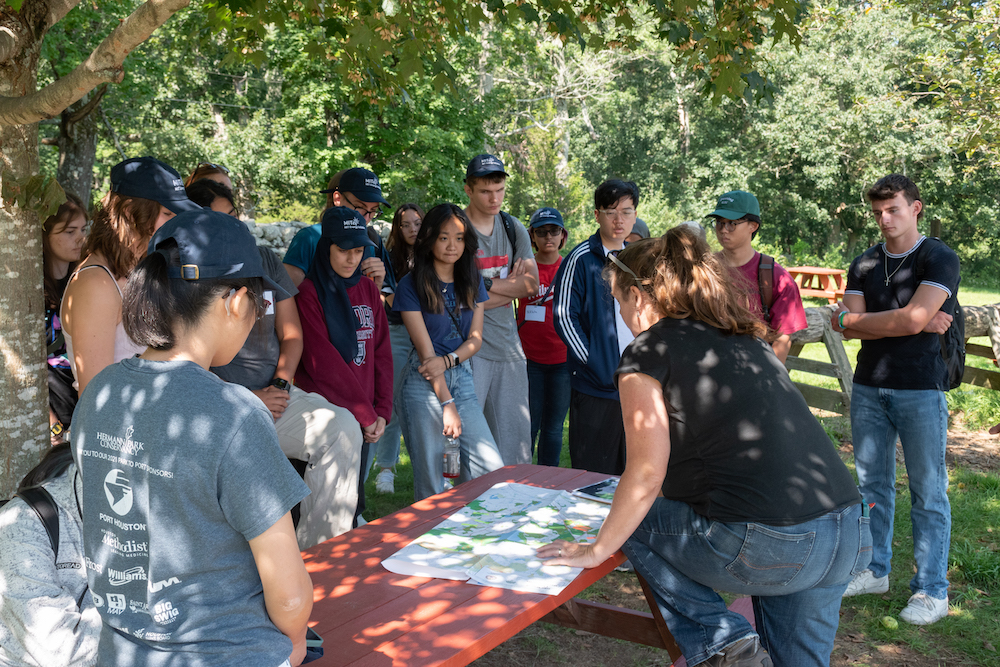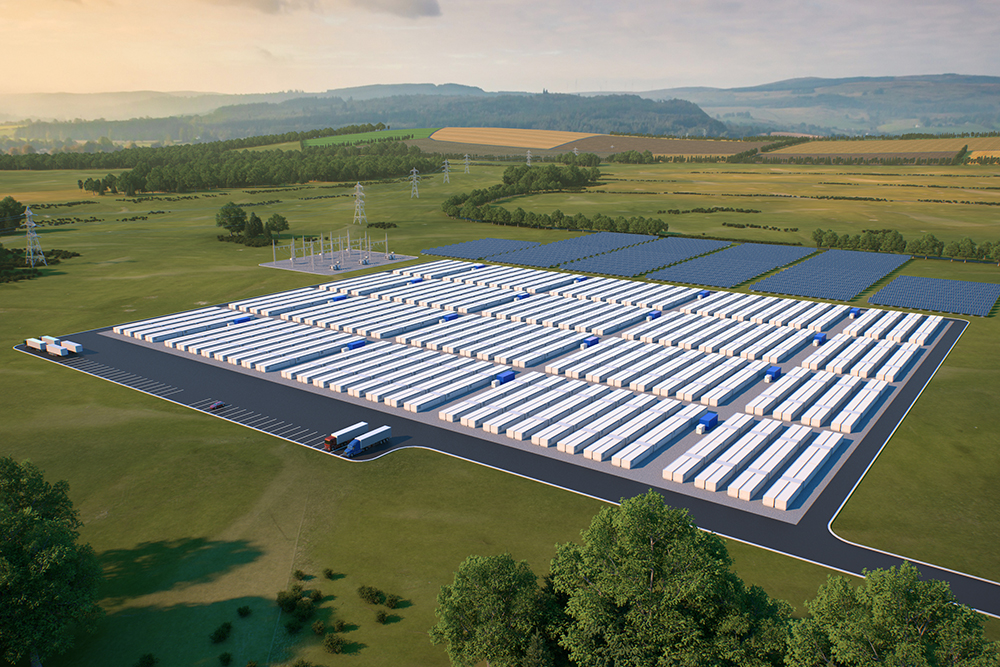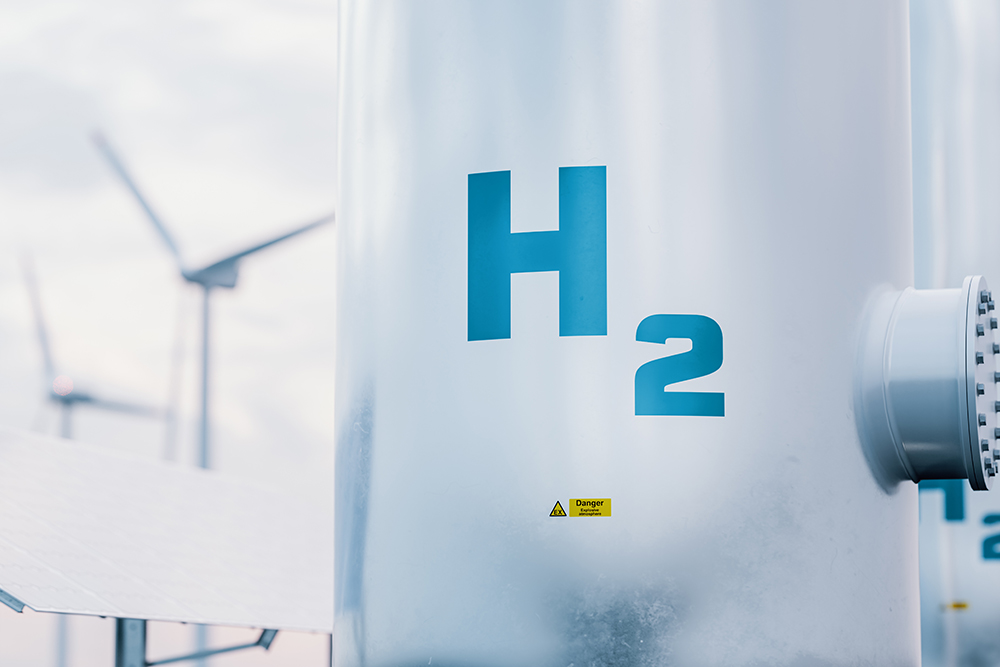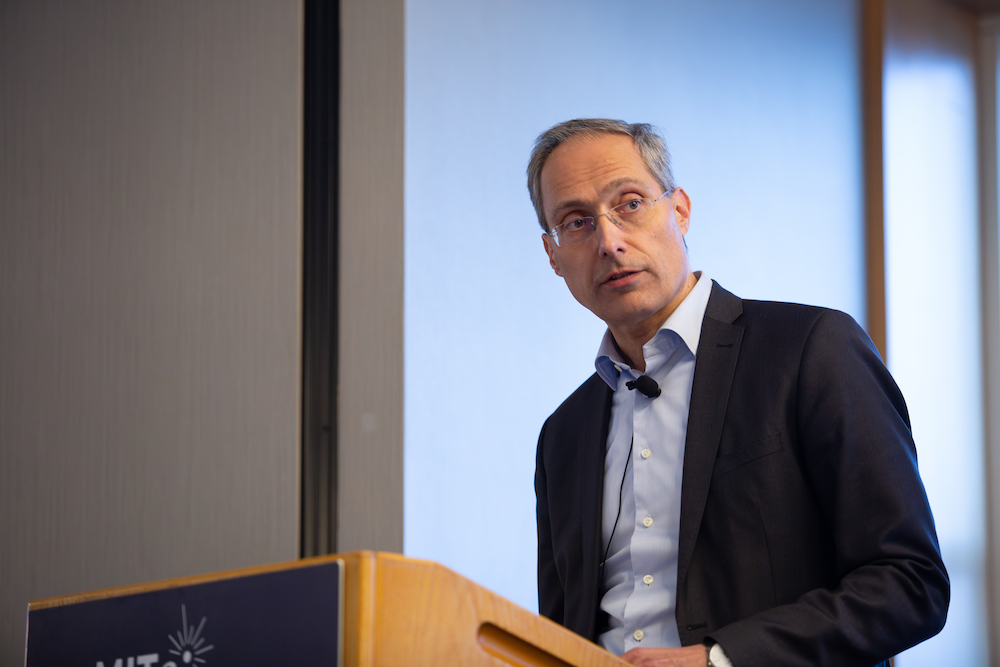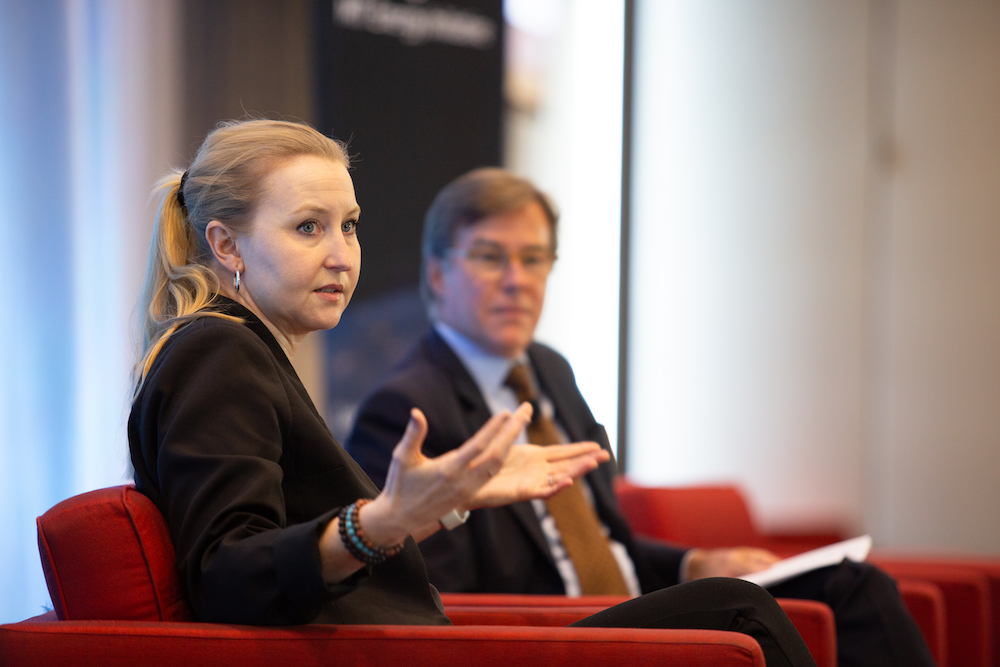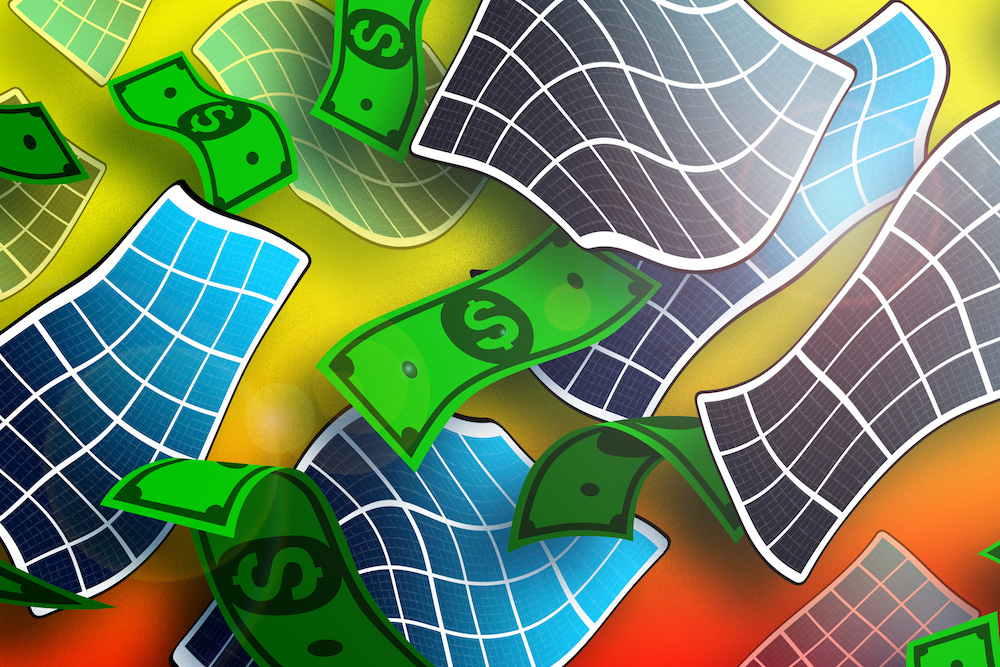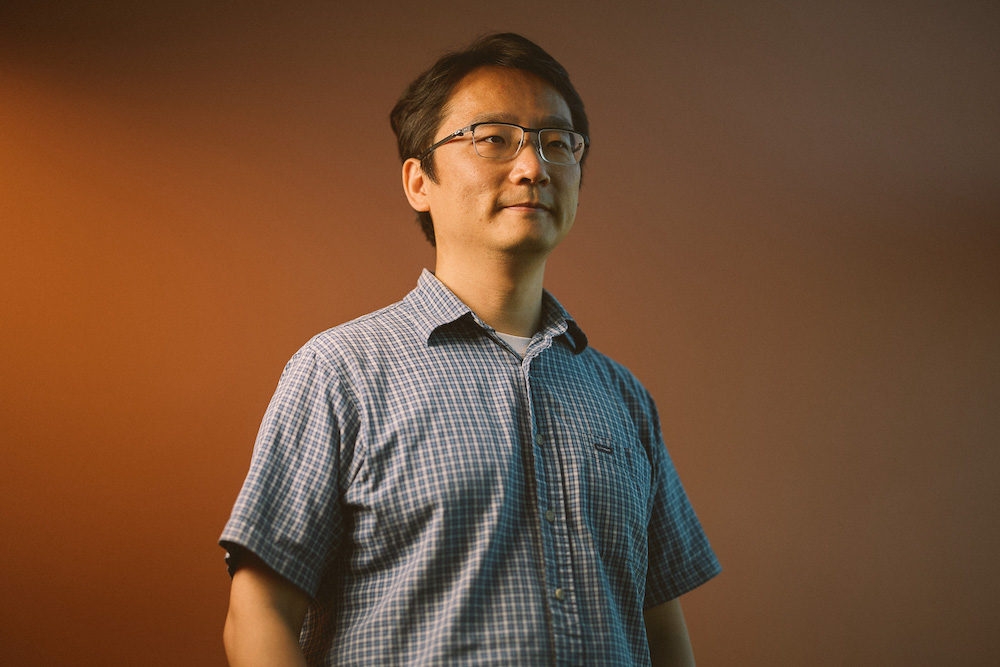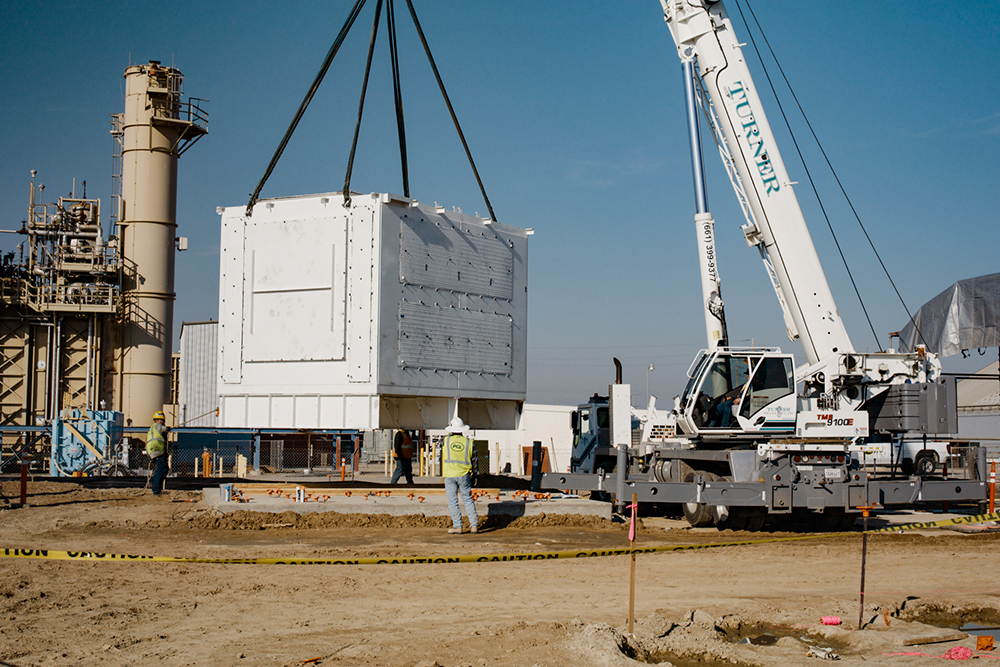Letter from the Director
Dear friends,
As the newly named director of the MIT Energy Initiative (MITEI), I am grateful to my predecessor Bob Armstrong, for the strong foundation of energy work he created; to Rob Stoner, MITEI’s interim director, for maintaining that momentum; to our researchers, faculty, and students who are passionately driven to advance the energy transition; and to MITEI’s members, who recognize the importance of this work and make it possible.

William H. Green
I took this role because I strongly believe we can stop climate change. MITEI has deep expertise in energy systems, technologies, resources, policy, and distribution. We understand the complexity of the energy transition. And we recognize the urgency with which it must happen. We are already making great strides transitioning from fossil fuels to cleaner sources of energy. Still, change is not happening fast enough. And success will only be measured in how much and how quickly we reduce greenhouse gas emissions.
MIT President Sally Kornbluth has identified climate change as “the greatest scientific and societal challenge of this or any age,” and has called on the MIT community to meet that challenge. MITEI, with our understanding of the science, systems, economics, and business of energy, and our relationships across academia, industry, and government, is answering that call with renewed vigor and purpose.
In order to succeed, and succeed quickly, we must all work together: universities and start-ups for innovation, government for policy, big companies for massive scale. Today, new clean technologies have difficulty competing with well-established processes powered by cheap fossil fuels, and big companies are reluctant to make major investments unless government policy reduces the risk.
Last spring, MITEI demonstrated how we can work together by bringing together the stakeholders in the energy transition for our Spring Symposium to explore the possibilities and challenges of obtaining cheap, clean hydrogen from geologic sources. This symposium exemplified what I believe is our best chance at success in solving complex challenges—gathering experts from all sectors, clarifying what remains unknown, considering pros and cons, and building consensus around promising technologies and how to advance them quickly.
Yet, with so many stakeholders, and such complicated energy systems, this work takes time. I believe we can accelerate the process of moving climate solutions from laboratory to large-scale commercialization by bringing these stakeholders together even earlier to discuss, develop, and fund solutions. As I envision MITEI’s future, I am focused on convening researchers, economists, industry, non-profits, and government to reach consensus on practical approaches to decarbonize our entire global economy as quickly as possible. Consensus reduces risk, and so encourages the massive investments needed to stop climate change.
While we develop these necessary advances, I recognize that to solve the climate problem, the entire global economy needs to change. We must all come to the table to address the challenges of every sector. With support from business and government, MITEI is searching for real climate solutions that the public will adopt, and that merit the huge investments necessary for wide deployment. Still, we must work harder and faster to transition our energy systems. For, it is by working collaboratively, and urgently, to solve these complex issues that we will successfully address the greatest threat facing humanity today.
Sincerely,

William H. Green
Director, MIT Energy Initiative
Hoyt C. Hottel Professor of Chemical Engineering
MITEI by the Numbers, FY24
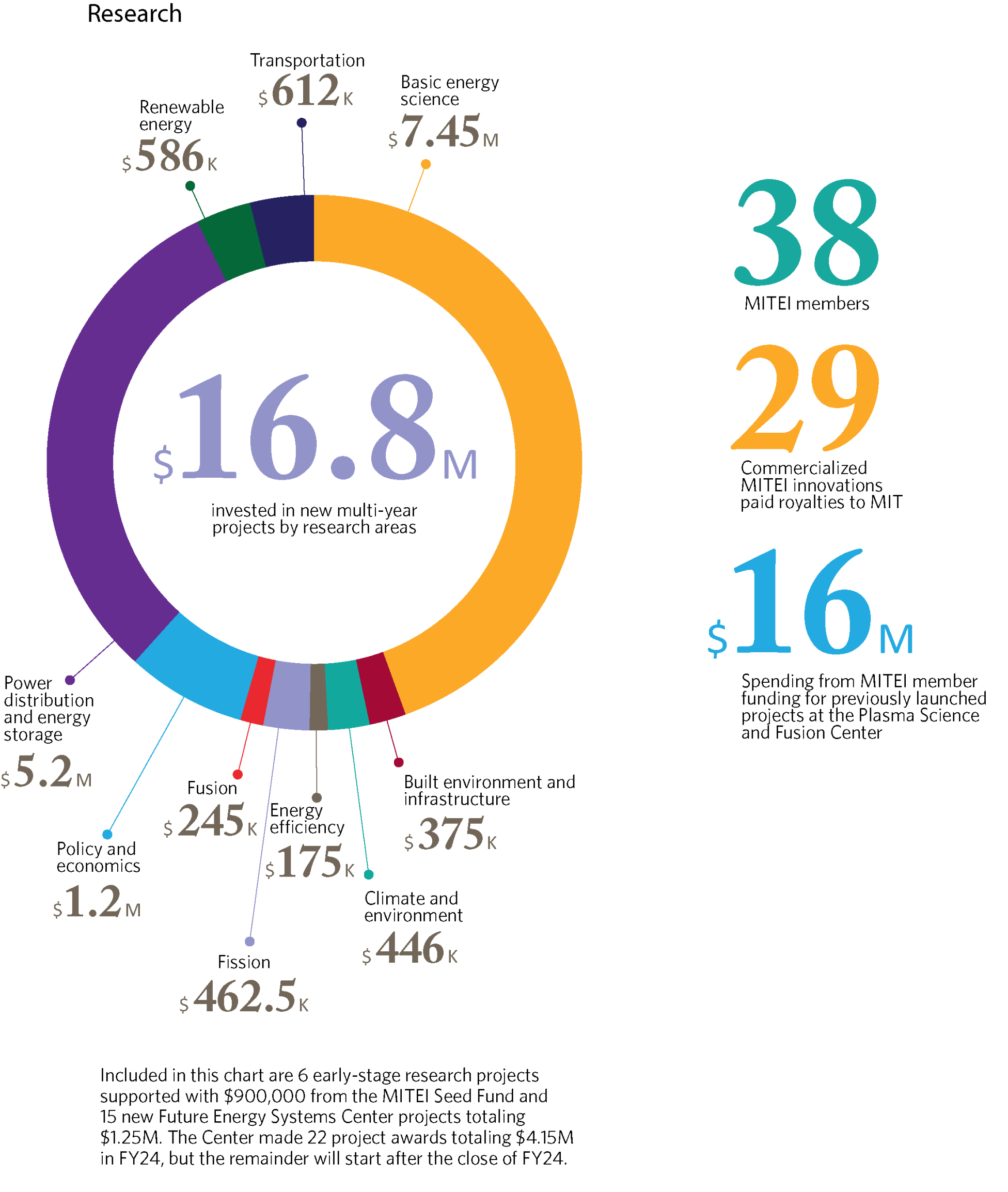


Overview and Mission
The MIT Energy Initiative (MITEI), MIT’s hub for energy research, education, and outreach is advancing zero- and low-carbon solutions to combat climate change and expand energy access. MITEI is a crucial rallying point for MIT researchers and educators who share our vision and commitment to dramatically reduce emissions through the development of novel technologies and delivery of science-based analysis. Together we are dedicated to decarbonizing global energy systems and building upon MIT’s long tradition of working collaboratively and transparently with industry, government, and civil society.
MITEI and its member companies and organizations support hundreds of research projects across the Institute, including those awarded through the MITEI Seed Fund Program for innovative early-stage energy research projects. MITEI contributes to the goals of MIT’s Climate Project through these efforts, as well as by supporting technology innovation for deep decarbonization and providing techno-economic analyses to inform the successful scaling of low- and no-carbon technologies.
The Future Energy Systems Center is a consortium-funded research portfolio that aims to foster and inform interdisciplinary energy research across MIT, accelerating our progress toward a net-zero carbon future. The Center is another vital component of MIT’s climate action plan and MITEI’s research program. Usingtechnoeconomic and life cycle analysis to examine energy pathways in different sectors, the Center enables its members to explore and develop strategic energy plans, taking into consideration technology, economics, and policy. There are 37 Center members—companies spanning four continents and involved in many industries, including energy, utilities, automotive, semiconductors, mining/metals, chemicals, telecommunications, infrastructure, insurance, and engineering/construction.
The Initiative also delivers comprehensive analyses for thought leaders, policy makers, and regulators, such as the “Future of” study series, the latest of which is The Future of Energy Storage, published in May 2022. This report, the ninth in the series, focuses on the role of energy storage in getting electricity systems to net-zero by mid-century by making them cleaner, more efficient, and more affordable. Another series of reports, which includes Insights into Future Mobility (2019) and Utility of the Future (2016), examines rapidly changing segments of the energy sector.
MITEI leads Institute energy education efforts and has engaged with thousands of students through sponsored research opportunities and other programs—preparing the next generation of innovators, entrepreneurs, and policy makers to collaborate on solutions to global energy challenges. Energy education programs include the Energy Studies Minor, Undergraduate Research Opportunities Program in energy, short modules during the Independent Activities Period, an energy-focused first-year pre-orientation program, the graduate Society of Energy Fellows, and online energy classes open to a global audience. Faculty associated with MITEI help shape energy education at both the undergraduate and graduate levels by teaching, advising, and developing new curricula.
MITEI’s outreach efforts foster dialogue within the research community and across the academic, industry, and government sectors and provide the public with context on current energy issues. In addition to informing public policy through research reports, MITEI facilitates this exchange of information by hosting and sponsoring events and by supporting faculty and staff participation in external events. The MITEI communications team also develops content to highlight MIT energy researchers, students, and their work across print and digital platforms, such as MITEI’s website, podcasts and audio articles, and social media, as well as through media outreach.
Research & Analysis
MITEI raised more than $53 million in the 2024 fiscal year (FY24), with the primary objective of decarbonizing the global economy with zero- and low-carbon technologies and integrated energy systems supported by effective policy. The funding amount is the sum of multi-year commitments made in FY24 from new and renewing members. Research projects launched by MITEI in FY24 totaled $16.8 million. The areas that garnered the most new research support this year were basic energy science at $7.45 million and power distribution and energy storage at $5.2 million. The balance of this year’s research funding was allocated to support a range of other energy topics, including renewable energy, policy and economics, and built environment and infrastructure. With support from its Members, as well as numerous foundations, donors, various government entities (state and federal), and university partners, MITEI has supported more than 1,050 projects through FY24. MITEI’s work is guided by the use of advanced system modeling and analysis techniques to understand the climate as well as financial, economic, and social impacts of available pathways against the complex backdrop of the energy system as a whole.
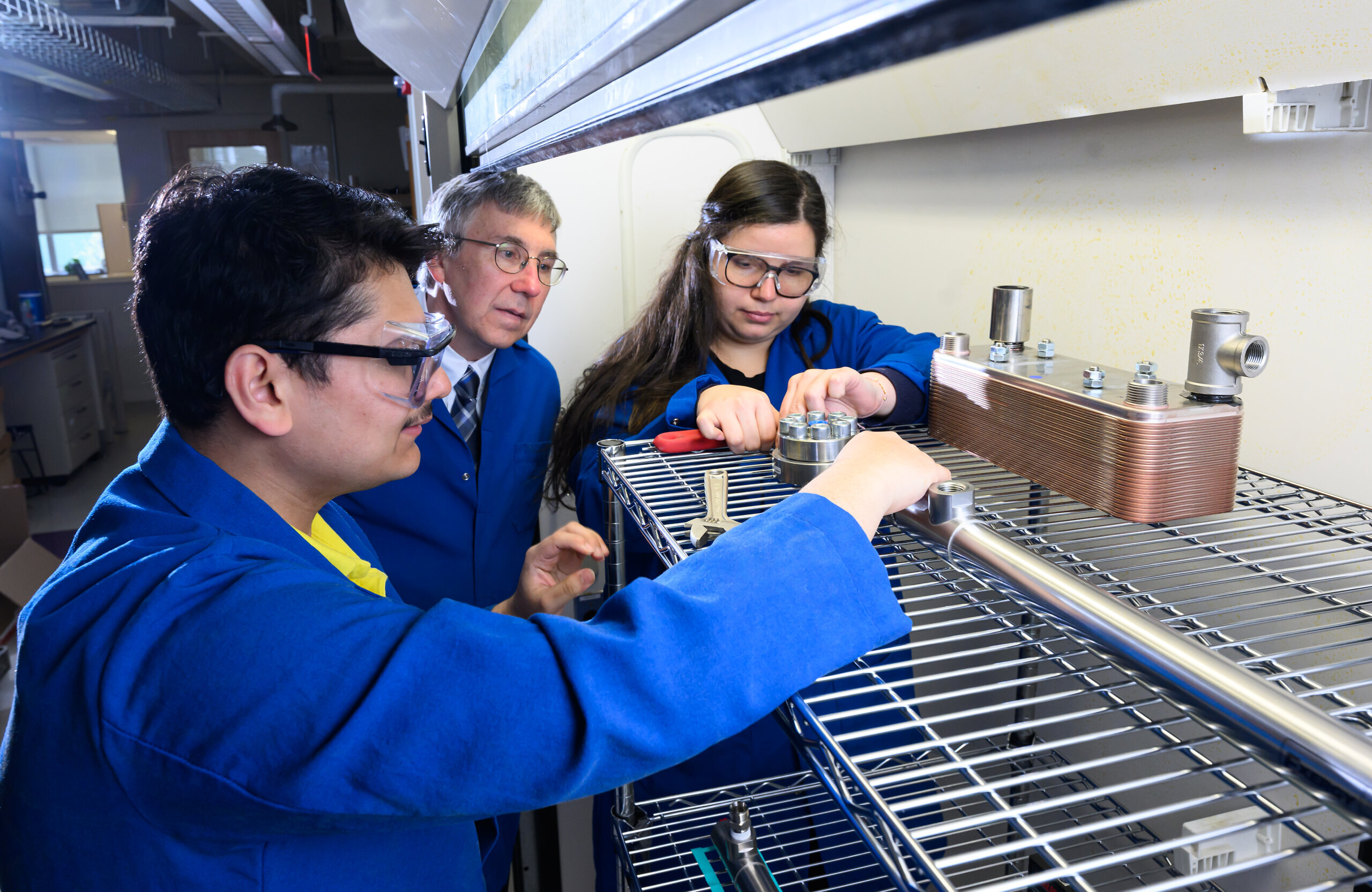
MIT researchers are exploring a promising plan to use clean-burning hydrogen in place of the diesel fuel now used in most freight-transport trucks—a change that would significantly reduce their greenhouse gas emissions. Photo: Gretchen Ertl
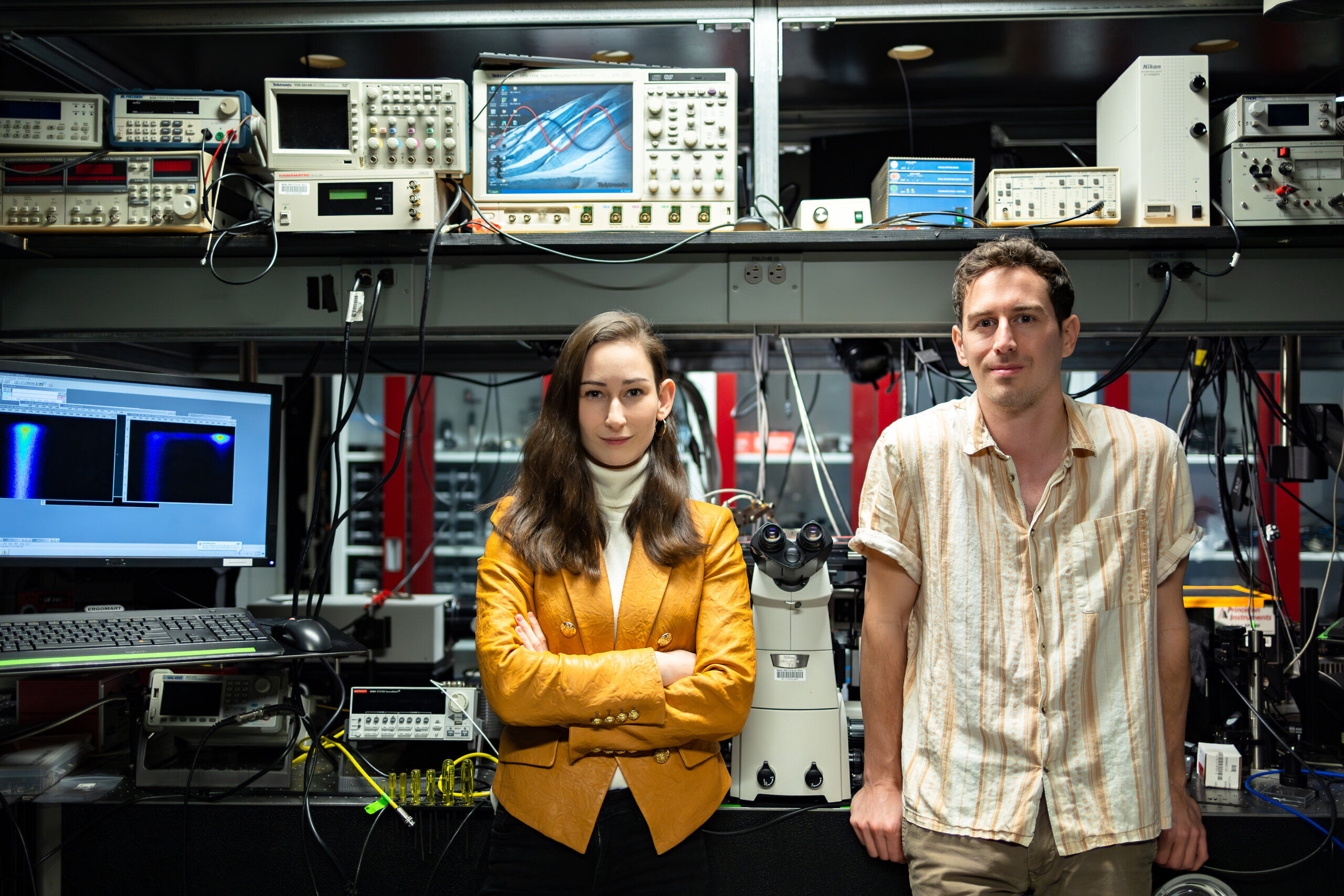
A team of MIT researchers and researchers from several other institutions has revealed ways to optimize efficiency and better control degradation by engineering the nanoscale structure of perovskite devices. Team members include Madeleine Laitz, left, and lead author Dane deQuilettes. Photo courtesy of the researchers.
MITEI Research Program Highlights
- The Future Energy Systems Center: The Future Energy Systems Center , which examines the accelerating energy transition as technologies, policies, demographics, and economics impact energy supply and demand, awarded $4.15 million to support 22 new projects. The Center is now carrying out 43 system modeling and analysis projects. The topics range from the hurdles of small modular reactors for industrial settings to the interplay between H2 production and renewable fuel synthesis. MITEI kicked off meetings for each of these new projects at the Center’s November 2024 Workshop.
- Future Energy Systems Center meetings and workshops: In May, the Future Energy Systems Center held its spring workshop to address pressing topics, including the role of bioenergy in the energy transition, decarbonizing buildings in cold climates, and the potential for nuclear power to play a significant role in the energy transition. It also held its advisory committee meeting and a student presentation and poster session.
- Future Energy Systems Center webinars: This series of webinars has provided an opportunity to share information about emerging technologies, policies, and sustainability issues from MIT professors across departments. The webinars also provide a venue for sharing the latest updates on the Center-supported projects.
- Funding for early-stage research: In FY24, MITEI funded six early-stage research projects for a total of $900,000, through the MITEI Seed Fund. MITEI has supported more than 220 energy-focused seed projects with grants totaling more than $28.8 million.
- Systems modeling tools: MITEI’s internal research team has made substantial progress toward further developing a unique and powerful set of energy system analysis and optimization tools. The Sustainable Energy System Analysis Modeling Environment (SESAME), a web application incorporating a growing number of features and capabilities for modeling energy system emissions and cost scenarios, is being used and expanded in projects funded by the Future Energy Systems Center and by industry. In 2023, the climate tech software startup Sesame Sustainability was spun out of MITEI, leveraging SESAME’s unique platform for technoeconomic and life cycle analysis to accurately evaluate industrial decarbonization solutions at scale. GenX, our state-of-the-art electricity system capacity expansion model for investment planning in the power sector, is being used in a number of Future Energy Systems Center projects, and by researchers and companies around the world. GenX was released as an open-source tool in 2021. A multi-sector expansion of the GenX model released as an open-source tool in 2022, the Decision Optimization of Low-carbon Power-HYdrogen Network (DOLPHYN), was used to inform multiple high-impact articles published in journals such as Nature Energy and Nature Communications.
MITEI funded projects in FY24
Principal investigators: John Parsons, Dharik Mallapragada Principal investigators: Xu Sun Principal investigators: Christopher Knittel Principal investigators: Paul Sclavounos Principal investigators: Dharik Mallapragada, Priya Donti Principal investigators: Jerry Hughes Principal investigators: Roberto Rigobon Principal investigators: Marija Ilic Principal investigators: Youssef Marzouk, Ruben Juanes Principal investigators: Audun Botterud Principal investigators: Guiyan Zang Principal investigators: Andy Sun Principal investigators: Susan Solomon Principal investigators: John Parsons Principal investigators: Timothy Swager Principal investigators: Kripa Varanasi, Trevor Hatton
Electric Power-H2-CO2 infrastructure interactions in a deeply decarbonized energy system
Modeling and computation study for optimal expansion and operation of decarbonized power systems
Energy efficiency behavioral experiment
Multi-fidelity floating wind optimization tool
Realistic, scalable, and security-constrained capacity planning for reliable low-carbon power systems
Fusion: Development of laser-based high-heat flux test stand
Evolution of environmental, social and governance metrics and their use in corporate governance for critical minerals
Toward enhanced microgrid performance: Benchmarking with existing operations and control on real world microgrids
CO2 migration along faults in carbon capture and sequestration projects: Field validation and stochastic modeling of fault properties
Flexibility and firm power in future zero-carbon power systems
Identification of the best steel decarbonization options for different regions
Optimization for the joint resiliency of power grid and e-transportation
Evaluating environmental impacts of hydrogen use and leakage
The place of provincial and international trade in Electric Power to maximize the value of Québec’s hydro resources
Opportunities for class-leading hydrogen sensors
Lithium extraction using a hybrid electrochemical thermal process
Publications published in FY24
Electrocatalytic Properties of Electrochemically‐Polymerized Metal‐Phenolic Networks
Rural electrification in India: A wicked problem
Inferring Fault Frictional and Reservoir Hydraulic Properties From Injection‐Induced Seismicity
Uncovering the Network Modifier for Highly Disordered Amorphous Li‐Garnet Glass‐Ceramics
Global Commission to End Energy Poverty
The Global Commission to End Energy Poverty is a collaboration between MITEI and the Rockefeller Foundation initiated in late 2018 to bring electricity to the remaining billion people across the globe who currently live without it. The Commission is led by Robert Stoner, founding director of the Tata Center for Technology and Design; and co-chaired by Ernest Moniz, special advisor to the MIT President, professor emeritus, and former U.S. Secretary of Energy; Dr. Rajiv Shah, president of the Rockefeller Foundation; and Akinwumi Adesina, president of the African Development Bank. The MITEI team’s “Energy Poverty Index,” which measures the capacity of countries with substantial energy poverty to achieve universal electricity access by 2030, is now being considered by the World Bank as part of its overall energy poverty tracking process. The African School of Regulation has been launched at the recommendation of the Commission to help build electricity system regulatory capacity across Africa and is under the interim leadership of Ignacio Pérez-Arriaga, a former visiting professor at the MIT Sloan School of Management from Comillas Pontifical University in Madrid, Spain. The school is based temporarily at the Florence School of Regulation in Italy and opened points of presence in six African nations over the course of 2023.
Tata Center for Technology and Design
Entering its twelfth year, the Tata Center for Technology and Design is supporting researchers at the master’s and PhD level to conduct energy research in developing countries. Their experiences abroad inform their ongoing research with the goal of catalyzing positive social impact in the form of policy support and affordable products and services. Through support for these students, the Tata Center, which is led by Tata Center Founding Director Robert Stoner, advances its mission of bringing technical talent and experience to bear on the challenges of the developing world. Ongoing projects focus on the social and financial impacts of ongoing fuel price shocks in vulnerable countries, the greenhouse gas and social impact of lithium-ion battery manufacturing in Indonesia, and the potential of retrofitting coal plants in India as thermal batteries to support renewables deployment while also reducing greenhouse gas emissions.
Education
MITEI supported 48 students through the Undergraduate Research Opportunities Program, welcomed 9 new graduate students and postdocs to the Society of Energy Fellows, and enabled 35 students to go on three field trips in 2023-2024, all as part of MITEI’s role as an educator of future energy change agents. MITEI’s educational efforts are critical to its mission as a catalyst for tomorrow’s low-carbon energy solutions. Through its various programs, MITEI provides a robust educational toolkit to MIT graduate and undergraduate students, global online learners, and high school students who want to contribute to the energy transition. These programs enable students to take classes; conduct research in diverse areas, from energy science and social science to technology and engineering; practice their skills; become leaders; and network with peers and professionals. MITEI’s education team serves on various climate-related committees to shape the Institute’s climate response and work with MIT faculty members to develop curricula and act as advisors to aspiring and current energy students.
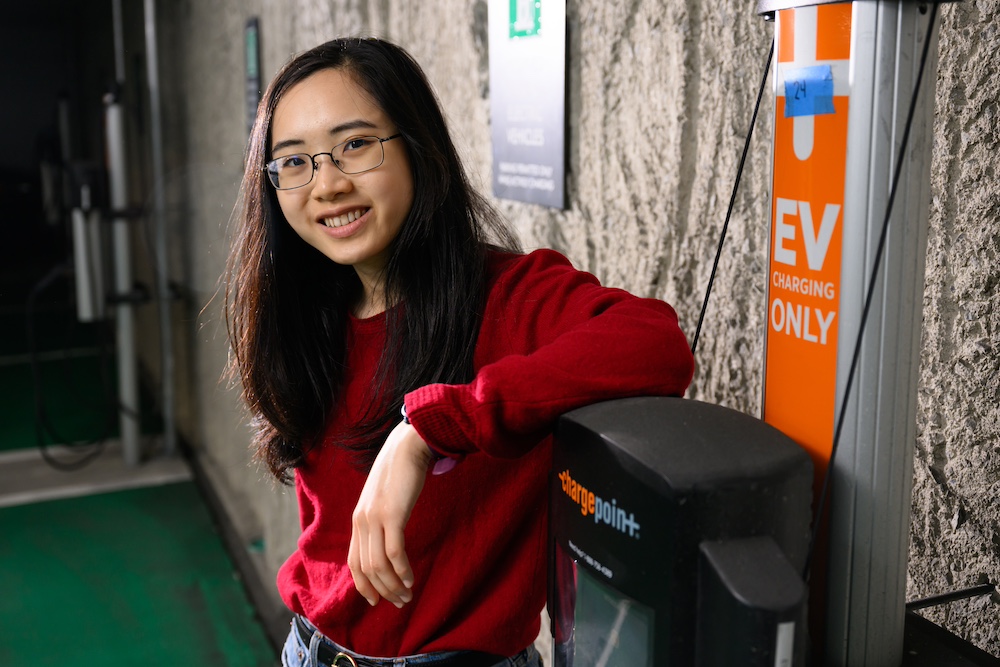
With a double major in mathematics and electrical engineering and computer science, MIT senior Elaine Siyu Liu is exploring the ways in which renewable energy and electric vehicles impact the power grid. Photo: Gretchen Ert
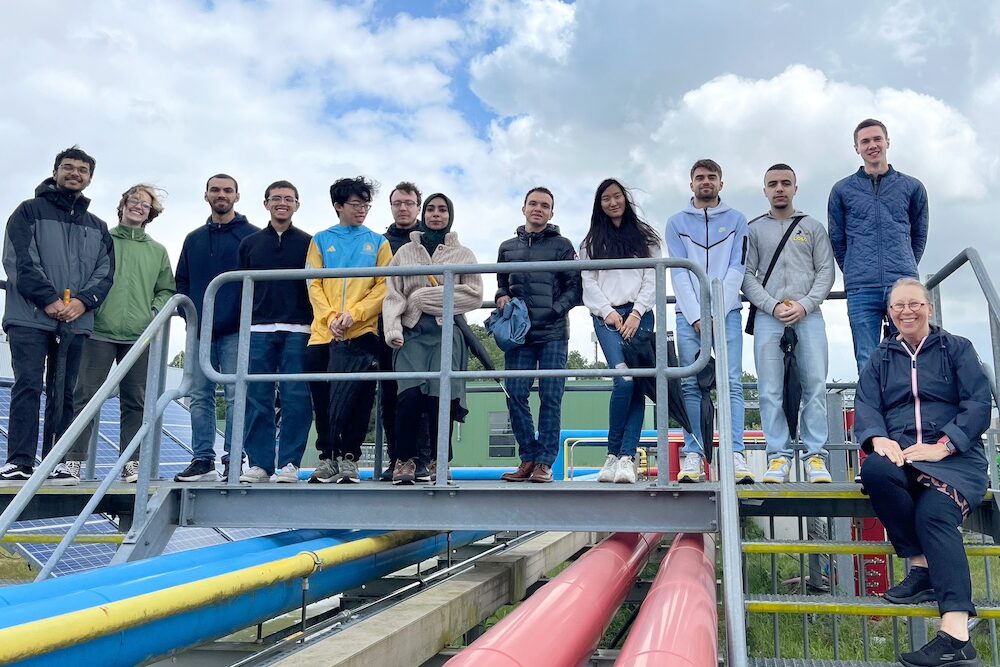
As part of a MITEI-sponsored field trip to the Netherlands to experience the country’s approach to sustainable energy, students received a tour of EnTranCe, a facility dedicated to researching hydrogen usage within the energy grid, at Hanze University in Groningen. Photo courtesy of MITEI.
MITEI Education Program Highlights
- Graduate Fellows: With the 9 new graduate students and postdocs MITEI welcomed to the Society of Energy Fellows in 2023-2024, the Energy Fellows network now totals more than 560 current and former graduate students and postdoctoral fellows, spanning 20 departments and divisions at MIT’s five schools and college. This year’s fellowships were supported by MITEI member companies Chevron, Eni, ExxonMobil, and Shell.
- Collaboration with GradEL: During the spring semester, in weekly interactive sessions, 14 graduate students from across campus were challenged to clarify how their work has potential impact and how best to communicate this. MITEI Education Director Antje Danielson co-taught the class 6.S640, “How will my research matter? Optimizing projects towards impact,” as part of the Riccio Graduate Engineering Leadership Program (GradEL). 100% of the survey respondents agreed that they are better able to talk about their research to different audiences after taking the class.
- Energy Systems Team Practicum: MITEI piloted the first team practicum at Shell TechWorks in Boston during IAP 2024. For one month, 14 MIT graduate students and postdocs from 10 disciplines worked on four climate- and energy-related projects, relevant to Shell’s future energy portfolio. They were supervised by MITEI and Shell staff with input from MIT faculty and researchers.
- Online energy courses: To train global professionals, policy makers, and students in research methods and tools to support and accelerate the energy transition, the MITEI education team has developed a series of open online courses (MOOCs) based on interdisciplinary residential MIT subjects. These courses are free and available in almost every country and have attracted more than 115,000 students. They engage critical aspects of future energy systems: load and demand-side management; economics and regulation; production, distribution, and transmission; and mobility. The courses include Sustainable Building Design; Sustainable Energy; Principles of Modeling, Simulation, and Control for Electric Energy Systems; Energy Economics and Policy; and Transformative Living Labs in Mobility.
- IAP courses: MITEI offered two IAP courses in January 2024. “Leading the Energy Transition” invites energy leaders to share their strategies in accelerating the change to a net-zero carbon world. “Computational modeling for clean, reliable, and affordable electricity” offers a hands-on learning experience introducing analysis techniques to model and understand the role of electric power systems within a carbon-constrained economy.
- First-Year Pre-Orientation Program: MITEI’s summer 2023 energy pre-orientation program welcomed 19 new first-year students to the MIT community. Activities included a visit to a wind turbine testing facility, tours of MIT’s Nuclear Reactor Lab and the Plasma Science and Fusion Center, a visit to a nearby sustainable farm, and sailing on the Charles (the original wind energy!).
- Energy Studies Minor: The Energy Studies Minor allows undergraduate MIT students to gain an integrative understanding of energy and develop the skills required of tomorrow’s energy professionals, leaders, and innovators in research, industry, policy, management, and governance. Over 200 students have graduated with the Energy Studies Minor, including 12 graduated in 2024.
- Undergraduate energy research: MITEI supported 48 student projects through the MITEI Undergraduate Research Opportunities Program during the 2023-2024 academic year, bringing its total of sponsored projects to 975.
- Field trips to Europe: In August 2023, MITEI Education Director Antje Danielson took 9 undergraduate and graduate students to Denmark to explore renewable energy startups and visit the Danish Tech University in Copenhagen. In June 2024, she took 7 students to the Netherlands, visiting the Ports of Eemshaven and Rotterdam, Hanze University of Applied Science’s Center of Expertise Energy, Groningen University, and a number of companies involved in offshore wind and hydrogen production.
- Support for student groups: MITEI provides financial and staff support for a number of student groups throughout the year. In FY24, these included the MIT Solar Vehicle Team, Electric Vehicle Team, StartLabs, SPOKES, MIT Motorsports, the MIT TPP Policy Hackathon, and the MIT Energy and Climate Hack.
- High school curriculum: MITEI Deputy Director for Policy Christopher Knittel (MIT Sloan) has developed the Climate Action Through Education (CATE) program and associated interdisciplinary high school climate curriculum with the MITEI Education team in a supportive advisory group role. Read more in Affiliated Groups, CEEPR section.
- MIT–University of Groningen faculty workshop: The MITEI education team collaborated with the MIT Catalyst Program on a faculty workshop in the broad areas of energy transition and healthy aging. The workshop was held on September 10–12, with nine MIT and 10 Dutch faculty, connecting with their peers, participating in structured experiences following the Catalyst/Impact methodology, and finding opportunities to work with one another.
- Course support: MITEI provided support for teaching assistants in the following subjects: IDS.521[J]: Energy Systems for Climate Change Mitigation, 22.081: Sustainable Energy, 11.165: Urban Energy Systems and Policy, EC.711: Introduction to Energy in Global Development, and EC.712[J]: Applications of Energy in Global Development. MITEI also provided course development funds for 11.S188/11.S3953: Indigenous Water and Energy Planning.
Outreach
MITEI hosted more than 300 speakers on campus, presented 26 webinars, and hosted 10 seminars, all in an effort to inform public policy, foster dialogue within the academic research community, and provide the public with context on vital issues. Convening events throughout the year, MITEI hosts thought leaders from across the energy value chain. MITEI staff, faculty affiliates, and graduate students share their research and perspectives at domestic and international events. Staff members also participate in Institute-wide efforts on addressing climate change. MITEI’s communications team highlights the research and achievements of faculty and students through articles, media outreach, social media, podcasts, and other digital and print platforms.

Paula R. Glover, the president of Alliance to Save Energy, speaks at the twelfth annual Clean Energy, Education, and Empowerment (C3E) Women in Clean Energy Symposium and Awards on a panel discussing how to strengthen existing policies and implement new ones to accelerate decarbonization. Photo: Gretchen Ertl
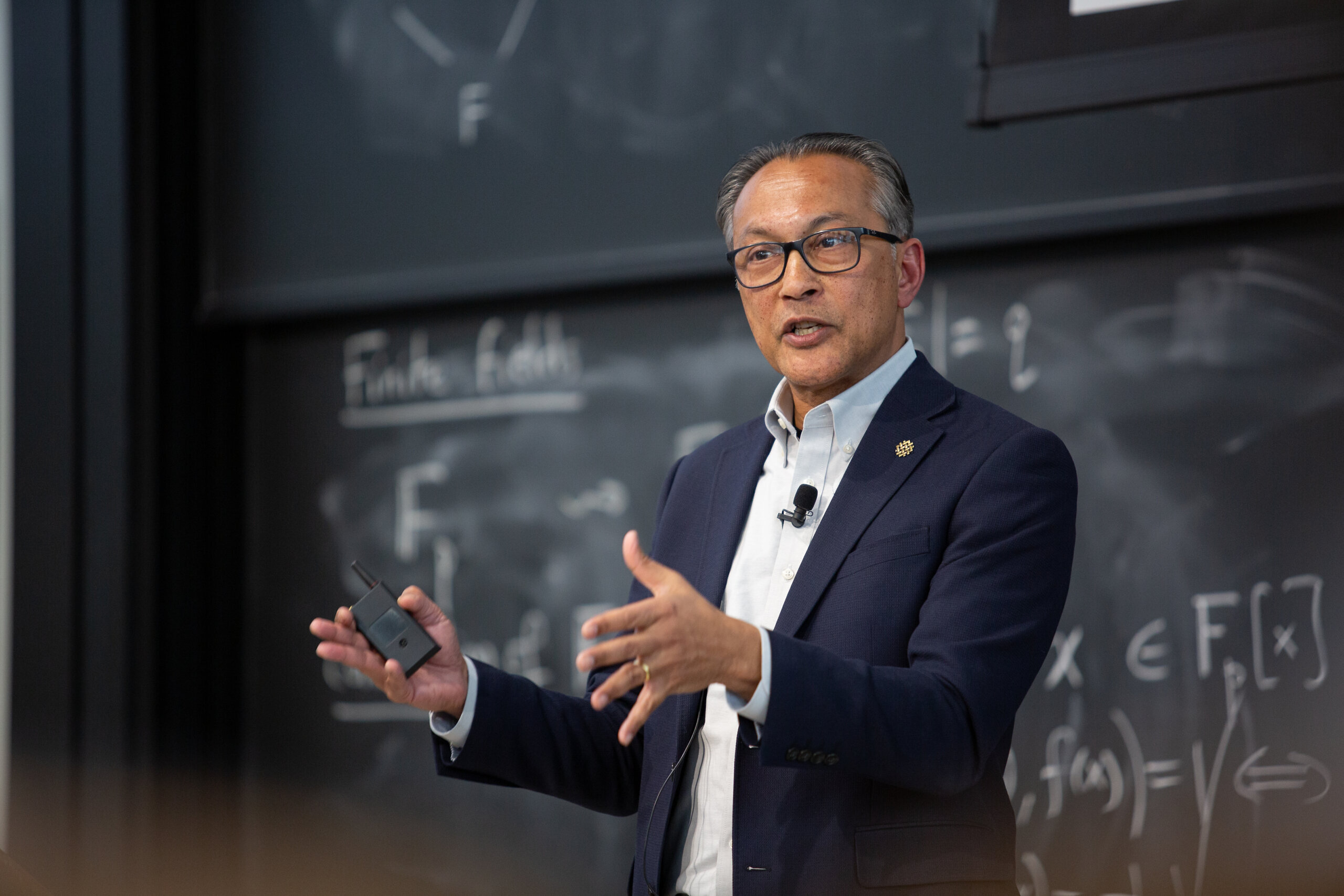
At MITEI’s Earth Day Colloquium, World Resources Institute President and CEO Ani Dasgupta stressed that systemic change is needed to bring carbon emissions in line with long-term climate goals. “It’s not one thing that needs to change,” he said. “The whole system needs to change.” Photo: Kelley Travers
Outreach Program Highlights
- Guest speakers: Leaders in policy, academia, and industry gave talks at MITEI-hosted events. Speakers included Yuri Sebregts, executive vice president of technology and chief technology officer at Shell; Praveer Sinha, CEO and managing director at the Tata Power Company Limited; Jeremiah Johnson, associate professor at North Carolina State University; Julie McNamara MS ’14, deputy policy director of climate & energy at the Union of Concerned Scientists; and more.
- Spring Symposium: In May 2024, MITEI held its Spring Symposium bringing together researchers, industry leaders, and academic experts to address the potential of geologic hydrogen as an energy source for the future. Speakers included Mary Haas, venture partner at Breakthrough Energy Ventures; Dirk Smit, independent consultant and scientist; and Avon McIntyre, executive director of HyTerra, Ltd.
- Earth Day Colloquium: As part of MIT’s celebration of Earth Week, MITEI hosted World Resources Institute President and CEO Ani Dasgupta to discuss how a just energy transition in key countries can lead to a global tipping point for a more resilient, equitable world.
- Annual Research Conference 2023: The event brought together energy researchers, policy makers, and industry members to explore policies and technologies that are shaping today’s energy system and its future. This year’s conference highlighted strategies for implementing large-scale reductions in the world’s greenhouse gas emissions. Students from the Undergraduate Research Opportunities Program participated in a slam, presenting their research to MITEI Members and conference attendees. Three of the conference sessions were open to the MIT community. These sessions discussed how large established companies will lead the massive energy transformation and generational perspectives on the energy transition, as well as a keynote on enabling commercial liftoff for clean energy technologies presented by Jonah Wagner, chief strategist in the Loan Programs Office at the U.S. Department of Energy.
- C3E 2023 Women in Clean Energy Symposium: In September 2023, the twelfth annual Clean Energy, Education, and Empowerment (C3E) Women in Clean Energy Symposium and Awards was hosted by MITEI in collaboration with the U.S. Department of Energy (DOE), Texas A&M Energy Institute, and Stanford Energy. The conference featured award presentations, as well as diverse speakers—including the former White House national climate advisor and Environmental Protection Agency administrator Gina McCarthy, Janelle Knox-Hayes (Urban Studies and Planning), Amy Glasmeier (Urban Studies and Planning), and Elsa Olivetti (Materials Science and Engineering)—and rich conversations on pursuing sustainable clean energy goals. The U.S. C3E Initiative advances clean energy by closing the gender gap and increasing the participation, leadership, and success of women in clean energy fields.
- Energy Futures magazine: After 32 editions, MITEI published its final issue of Energy Futuresmagazine in Winter 2024 and pivoted to a digital-first editorial strategy. Since 2008, this magazine was published twice a year, featuring energy research and other energy activities at MIT. This work will continue on MITEI’s website on an ongoing basis.
- Audio articles: MITEI produced and released a series of audio articles on the future of energy at MIT. Topics include new startups, novel energy research, event coverage, and alumni profiles.
MITEI news from FY24
MIT reports of MITEI impact
MITEI Members
MITEI increased and diversified its corporate memberships, renewed several current memberships, and enabled 19 students to visit a member site to learn about large-scale industrial decarbonization through its corporate member program. With this program, MITEI facilitates collaborations between industry and MIT to research, develop, and accelerate low- and zero-carbon solutions for the energy transition. MITEI’s member roster is reflective of MITEI’s mission to work across the broad industrial spectrum of energy production, conversion, delivery, and usage. Along with financial support for research, analyses, and education, industry members contribute valuable perspectives and detailed knowledge of real-world conditions for practical scaling-up, deployment, and integration of decarbonization solutions.
MITEI draws on MIT’s research capabilities, innovation, expertise, and experience to create successful industry collaborations to meet its research partners’ key strategic objectives. A multi-tiered membership structure enables diverse private-sector partners to sponsor multidisciplinary “flagship” research programs with MIT faculty; contribute to energy-focused labs, programs, and centers at MIT; fund critical energy fellowships; support innovative energy concepts from proposals solicited across the campus; and participate in MITEI’s seminars, lectures, and colloquia.
Member Highlights
- Overall, during FY24, MITEI’s net membership roster grew from 36 to 38 members. As evidence of our efforts to diversify across the energy spectrum, we welcomed several key new members, including Vale, Liberty Mutual, and Taiwan Power Company.
- One of the key activities for FY24 was renewing the memberships of MITEI’s major members, including founding member Eni and sustaining members Chevron and Equinor. In addition, MITEI welcomed Petronas as a new sustaining member and Type One Energy as a new startup member.
- Building on MITEI’s mission as a hub for education, we facilitated a student field trip to ExxonMobil’s massive Baytown, TX, complex. Nineteen undergraduate and graduate students from across MIT toured this facility—one of the largest integrated petrochemical, ethylene, and advanced recycling plants in the world—and see their carbon capture pilot plant in operation. They received an in-depth presentation and discussion on ExxonMobil’s plans for decarbonizing the complex via hydrogen power and carbon capture.
- Leveraging our power as a convener of multiple energy stakeholders, we dedicated one of our sessions during our Annual Research Conference to hearing from students about their concerns and priorities for the energy transition. The students were also invited to attend the other parts of our conference to observe MITEI’s interaction with corporations and directly speak with industry on important—and sometimes controversial—energy transition topics.
- As members’ research organizations recover from Covid-19-related disruptions, they are expanding their sponsored research portfolios and we anticipate continued growth.
- In collaboration with the EPOCH Foundation, MITEI launched Taiwan’s Innovative Green Economy Roadmap (TIGER) Consortium in FY23. The program focuses on engaging Taiwan’s industry leaders and MIT experts in developing a long-term robust roadmap for Taiwan in its transition to a green economy based on innovative low-carbon technologies. In FY24, two new members joined TIGER.
View the full list of members.
Affiliated Groups
MITEI collaborates on research and education activities with faculty members from many MIT centers, departments, and laboratories pursuing interdisciplinary energy and environmental activities. In particular, researchers from both the Center for Energy and Environmental Policy Research and the Joint Program on the Science and Policy of Global Change are working with MITEI researchers to support the work of the Future Energy Systems Center.
Center for Energy and Environmental Policy Research
Established in 1977, the Center for Energy and Environmental Policy Research (CEEPR) promotes research on energy and environmental policy to support improved decision-making by government and industry. It is directed by Christopher Knittel (MIT Sloan) and jointly sponsored by MITEI, the Department of Economics, and the MIT Sloan School of Management.
CEEPR carries out rigorous and objective research for improved decision-making in government and the private sector, and closely cooperates with government and industry partners from around the globe. Affiliated faculty and research staff as well as external research affiliates contribute to the empirical study of a wide range of policy issues related to energy supply and demand and the environment. A legacy of excellence in energy economics, enhanced with interdisciplinary cooperation across MIT’s schools and departments, informs pioneering research on pressing challenges in energy and environmental policy.
CEEPR produces working papers, policy briefs, and research input to larger, interdisciplinary studies, and hosts two annual research workshops at MIT. CEEPR has extensive previous and current international collaborations and has co-organized a series of international energy policy conferences, including partnerships with the Energy Policy Research Group at the University of Cambridge, UK, the Technical University of Denmark, and the Copenhagen Business School.
CEEPR houses the Roosevelt Project, a research initiative which takes a multidisciplinary approach to examining the transitional challenges associated with deep decarbonization of the U.S. economy. The project was initiated by former U.S. Secretary of Energy and Cecil and Ida Green Professor of Physics and Engineering Systems emeritus Ernest J. Moniz and engages a breadth of MIT and Harvard faculty and researchers across academic domains including economics, engineering, sociology, urban studies and planning, and political science. Phases One and Two are complete. Phase Three is currently underway and includes studies on long-distance electric transmission, strategic metals and minerals, and low-carbon steel in the United States.
CEEPR is also host to MIT Institute Innovation Fellow Brian Deese and his team. Over the past year they focused their efforts on launching the Clean Investment Monitor (CIM), which tracks public and private investments in climate technologies in the United States. Through this data and analysis, the CIM provides insights into investment trends, the effects of federal and state policies, and on-the-ground progress in the United States towards net-zero greenhouse gas emissions. It has already been cited multiple times in several high-profile media stories and used by the wider public in analyses and assessments of the Inflation Reduction Act.
Joint Program on the Science and Policy of Global Change
In August 2024, the MIT School of Science launched a new center, under the leadership of Professor Noelle Selin, called the MIT Center for Sustainability Science and Strategy (CS3), incorporating and succeeding both the Joint Program on the Science and Policy of Global Change and the Center for Global Change Science, both of which previously had been led by Professor Ronald Prinn. While adding new capabilities, CS3 aims to produce leading-edge research to help guide societal transitions toward a more sustainable future. Drawing on the long history of MIT’s efforts to address global change and its integrated environmental and human dimensions, CS3 is well-positioned to lead burgeoning global efforts to advance the field of sustainability science, which seeks to understand nature-society systems in their full complexity.




